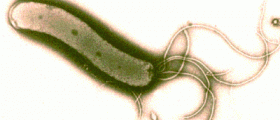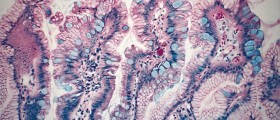
The digestive tract comprises many organs and bleeding may originate from each of them. Bleeding in the digestive system is not an illness per se. It is only a sign that something is going on in the gastrointestinal tract. In some cases a person may notice fresh blood mixed in stool or drops of blood sprinkled on the stool. This points to bleeding from the lower portions of the digestive tract. On the other hand, blood originating from the upper portions of this system is mixed in stool and gives it tar-like appearance.
Clinical Characteristics of Bleeding in the Digestive Tract
Symptoms and signs of such bleeding generally depend on the amount of lost blood, the affected part of the gastrointestinal tract and the actual cause of bleeding. Bleeding from the esophagus or the stomach is usually in a from of bright red blood in vomit. Black and tarry stool, as it has already been mentioned, occurs in case of bleeding from the small intestine and some parts of the colon while dark blood mixed in stool originates from terminal parts of the colon. And finally, stool with traces of fresh blood or coated with it usually originates from the rectum.
Severe bleeding is an emergency condition. Mild bleeding which lasts for a long period of time eventually causes anemia and all it symptoms and signs such as weakness, dizziness, shortness of breath, paleness etc. Causes of Bleeding in the Digestive Tract
So many medical conditions and disorders of the organs of the gastrointestinal tract may cause acute or chronic bleeding.
As for the upper part of the gastrointestinal tract bleeding may be caused by esophageal varices, Mallory-Weiss tears, esophagitis, gastritis, peptic ulcers (stomach and duodenal ulcers) and benign tumors or cancers of the esophagus, stomach or duodenum.
On the other side, bleeding from the lower portion of the digestive tract develops due to diverticular disease, colitis, different infections caused by viruses and bacteria, Crohn's disease, hemorrhoids, fissures, angiodysplasia, polyps and cancer.
Diagnosis and Treatment for Bleeding in the Digestive Tract
Before treatment begins it is essential to locate the actual site of bleeding. This can be achieved with several diagnostic methods including nasogastric lavage, endoscopy, enteroscopy or other procedures such as barium X-ray, radionuclide scanning, angiography and exploratory laparotomy.
Treatment for bleeding in the digestive tract depends on the affected organ, the underlying cause, patient's age and general health. Endoscopy can be, apart from diagnostic purposes, used for treatment. Namely, it is essential part of treatments such as injecting chemicals into the bleeding site and treating the bleeding site with a heat probe, electrical current or laser. It is also necessary for closing of the affected blood vessels with a band or a clip. If the previously mentioned methods do not work, a person is treated surgically while older patients who cannot be operated undergo medicamentous treatment.

















Your thoughts on this
Loading...